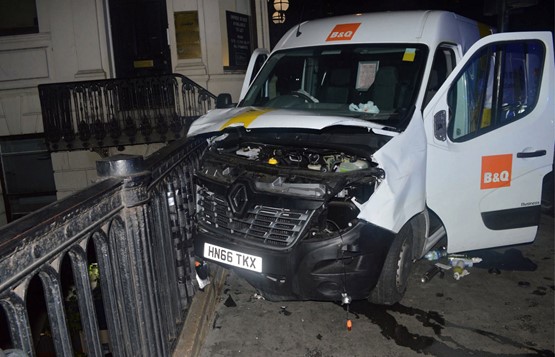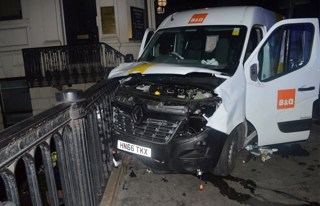Terrorists have used commercial vehicles as weapons in the most recent attacks in the UK and Europe. We examine the risks and the precautions fleet operators and drivers can take. By Andrew Don
In recent years, fleets have had to face an increasing security threat: the possibility that one of their vehicles may be used in a terrorist attack. Last year, 14 people were killed in London in three separate Vehicle as a Weapon (VAAW) attacks where commercial vehicles have been used as ramming devices.
Across Europe, the impact has been even greater. Since 2016, four other attacks have taken place, resulting in a further 126 deaths.
“The threat to the UK from terrorism is high,” says Wayne Watling, of the counter terrorism focus desk, Metropolitan Police road and transport policing command, who was involved in developing an online counter terrorism training module for FORS Professional.
Security services acknowledge that terrorists are increasingly relying on home-grown, ‘low-tech’, ‘lone-agent’ attacks against public spaces in the West, with propaganda being distributed favouring vehicles as a weapon.
Nick Caesari (below), managing director at Fleet Source, adds: “These incidents are very real, and the industry should be doing all it can to prevent drivers being involved in these horrific events.”
However, although it may feel like this attack method is becoming more widespread, the likelihood of a vehicle attack is low: 37 million vehicles are registered in the UK, UK residents make around 15.5m rental transactions in the country each year (10.9m: cars, 4.6m: vans), yet only a handful have been used as weapons in this way.
Even so, fleet operators can help reduce the risk of these incidents occurring.

Counter-terrorism training
A number of organisations have launched training programmes to raise awareness of the issue, something which is not particularly widespread.
Fleet operators’ association ACFO and training body ICFM say it is not an issue that has raised its head with their members and customers.
A survey with drivers and transport managers carried out by Fleet Source as part of the development of its Terrorism Risk and Incident Prevention (TRIP) course showed that just less than a quarter of respondents had never considered their chances of their vehicle being involved in a terror attack.
Awareness is building though, says Mick Kemp (below), training director at Fleet Source.
Since the launch of TRIP in October last year – just weeks after the Barcelona VAAW attack in August 2017 and the London Bridge/Borough Market attacks in June – more than 1,500 drivers have been trained, so the threat and levels of concern became dramatically raised within the industry.
Fleet operators are now opting for the training as a relevant and new option for drivers to undertake as part of their professional driving requirements.

“Drivers are embracing the training as they value training that will help them to not only protect their vehicles, but themselves and the public,” he says.
The TRIP training can also be used as the basis for transport and line managers to educate their drivers, with Skanska one of the companies which uses it for toolbox talks.
FORS has also launched a new security and counter-terrorism online training resource.
The e-learning module aims to increase a driver’s attention to personal and vehicle security, and to the potential threat to terrorism, specifically theft of vehicles or loads and the use of vehicles as weapons.
Developed in conjunction with Transport for London, the Department for Transport, The Metropolitan Police, High Speed 2 and the DVSA (Driver and Vehicle Standards Agency), the course is aimed primarily at drivers, although FORS is encouraging transport managers to undertake it.
“The knowledge gained will help drivers and operators ‘do their bit’,” says Watling.
Fleets and the vehicle rental industry are being encouraged to take part in the national counter-terrorism awareness campaign ACT (Action Counters Terrorism).
More than one-fifth of reports from the public produce intelligence which is helpful to police, and the campaign urges people to report suspicious activity or behaviour.
“It is important that drivers and operators report anything suspicious to the police as soon as possible,” adds Watling.
Prevention through technology
Telematics systems can be key to ensuring the safety of drivers and vehicles.
Paul Jorgenson (below), founder and senior partner at logistics management consultancy Strategic Analytics Team, recommends fleet operators consider installation across their fleets if they do not already have them.
He recommends journey management systems that track all aspects of how the load, vehicle and driver are managed from beginning to end.
Energy companies in more remote environments have used such systems to protect drivers and vehicles but they are now being used more widely to save money and make transport operations more efficient, says Jorgensen.
One aspect of journey management that can provide an immediate layer of security is route planning and geo-fencing, helping to protect the driver, but also bringing in the potential of reduced mileage, improved fuel usage and environmental impact as well as an increase in the use of vehicles.

“The combined use of telematics systems, cameras and proximity sensors alone will begin to deter any would-be thief – or worse still, a potential terrorist – from taking your vehicle to be used as a weapon,” says Jorgenson.
In the unlikely event that this does happen, fleet operators would be able to contact emergency services through the technology – be that an on-board system or app on a smartphone – and direct them to the exact location of the vehicle so they can take any appropriate action.
Kemp says that while technology is helpful, the focus, as an industry, should be on prevention and what a driver can do to stop a vehicle being taken, tampered with or hijacked.
Manuel Magalhaes, vice-president of Global Alliances at Digital Barriers, says operators can install a low-cost 3G dashcam enabling discreet real-time driver ID authentication via facial recognition, which can be processed remotely in a General Data Protection Regulation-approved workflow.
“In the case of a non-authorised person trying to start or drive a vehicle, an alert could be sent to the respective workflow recipients, for example the fleet’s security team or fraud department for a second verification and action,” he says.
Physical barriers
Debbie Heald (pictured), managing director of Heald, a designer and manufacturer of ‘hostile vehicle mitigation systems’, warns that those who are intent on committing terrorist offences will always find a way to obtain the tools they require.
“There are many ways in which a terrorist or organised crime group will obtain a vehicle, and that is to either steal it while it is out on the road or from the premises at which it is stored,” she says.
A variety of measures can be put in place at premises where vehicles are stored to mitigate the theft threat and protect the vehicle storage perimeter from being breached on both sides, adds Heald.
Arm barriers have traditionally been the security measure of choice because of ease of install, low cost and the fact that people, generally, do not intentionally drive through them.

However, those with plans to obtain a vehicle for purposes of crime will give no second thought to driving through such measures and, ultimately, these products will offer little in the way of protection, Heald says.
“When considering perimeter protection, all current measures need to be analysed. For example, could a vehicle easily penetrate, or could existing measures be unlocked or cut away?
Following this, you then need to consider traffic flow, i.e., how do you need vehicles to move in, out and around the premises? Once you understand all of that, you can then identify the most practical solutions available.
“It may be that to secure the majority of the perimeter, static bollards will offer both a practical and more secure solution than fencing, but for areas where traffic needs to move around then retractable or sliding bollards will provide a more secure solution than arm barriers and gates.”
Another consideration is the size of the opening required. Sliding and retractable bollards can be operated in an array, meaning that you can open the space dependent upon the size of vehicle permitted entry or exit.
Significant excavation
Historically, bollards which offer the ability to slide or retract have not been possible for many sites because of the need for significant excavation or the requirement to have electricity cables running to the products.
“However, with advances in both shallow and surface-mount products, the need for extreme excavation, significant power operation and lengthy install times have drastically reduced,” Heald argues.
Gavin Hepburn, director at ATG Access, an innovator of road blockers, bollards and barriers, adds that while security is important to stop access to vehicles in the first place, physical security measures, such as bollards and barriers are also effective at bringing terrorist vehicles to a standstill.
“It is crucial that safety and security is stepped up to combat the growing threat of terror as an attack can never be ruled out,” he says. “Governments are becoming more responsive and CV drivers will likely see more physical security measures in place while they’re out and about.”
Differing security challenges
Jorgensen says operators of hire fleets, for example, will have different security risks to those of goods commercial fleets, and the security challenges will be different again where companies have large fleets of cars and small vans.
The British Vehicle Rental and Leasing Association (BVRLA), which the National Counter Terrorism Security Office has accredited to deliver one-day counter terrorism awareness workshops to the rental industry, says the industry is in frequent contact with the Home Office, Department for Transport, Counter Terrorism Unit, insurers and a range of other government and law enforcement contacts.
“The bottom line is that if someone presents the correct paperwork, licence and means of paying for a vehicle, it is very difficult to turn them away,” says BVRLA chief executive Gerry Keaney.

A criminal record will not really help because that does not bar a customer from renting a vehicle. Racial profiling is also difficult and requires a lot of training. “Even the security forces have been known to get it wrong,” says Keaney.
Any customer-facing business trying to use racial profiling would be left open to claims of discrimination.
“We have to remember that the front-desk staff at rental companies are trained to deal with customers, not identify or deal with terrorists,” he adds.
“These people don’t come into rental branches wearing bomb vests and dressed for combat. They look like any other customer and present legitimate ID and credit cards.”
Best practice for van and lorry drivers
- Daily walk-around, thorough checks on the vehicle and assessing any potential tampering
- Plan routes in advance to avoid any difficult manoeuvres and situations
- Do not leave vehicle unlocked or unattended with the engine running or keys in ignition
- Stay in safe and secure parking areas when parking overnight and taking rest breaks
- Understand what to look for when stopped by authorities, Driver and Vehicle Standards Agency and undercover police
- Look out for suspicious behaviour. Be the eyes and ears of the road
- Be aware of ‘ACT’ – Action Counters Terrorism and ‘Run, hide, tell’ Government campaigns
Best practice for fleet operators
- Ensure drivers are knowledgeable via driver training, toolbox talks and Government videos
- Businesses should have a policy in place on terrorism and vehicle attacks for all staff
- Distribute policies and procedures to all staff concerned and acknowledged
- Investigate areas of the business that could be vulnerable to suspicious activity, for example, the security of your site and vehicles, driver whereabouts and, if you are using agency drivers, ensuring that you are aware of the individuals that will be driving your vehicles
- Make sure drivers are aware of key, site and vehicle security
Source: Fleet Source


















Login to comment
Comments
No comments have been made yet.